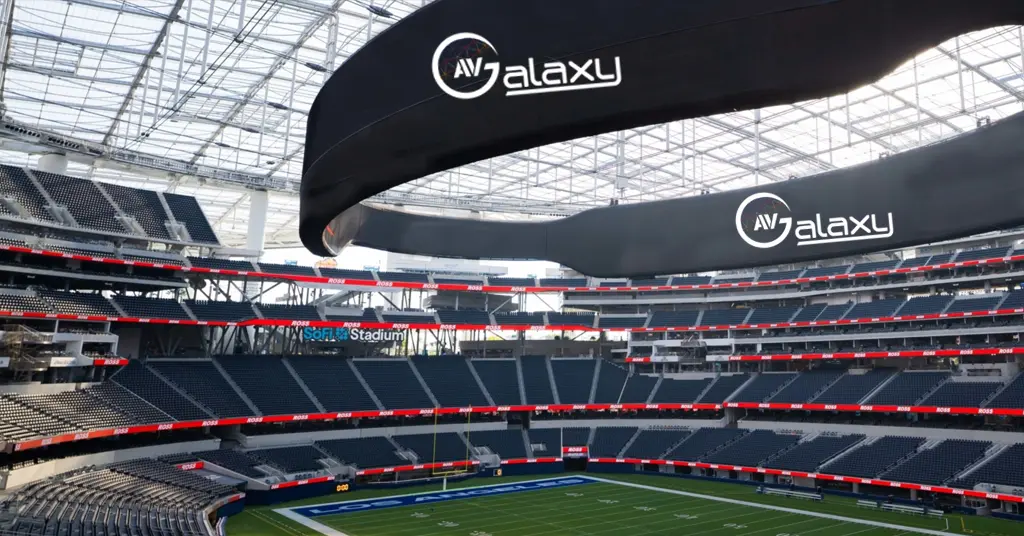The Ultimate Guide to Controlling Power Consumption of Stadium LED Screens
The large LED screen of the stadium will consume a lot of power energy during normal operation, which will lead to high electricity bills and reduce the final benefits of the event operators.
In this article, we’ll explore 6 different ways to control the power consumption of a stadium LED screen in different modes of operation.
Galaxyav has a history of more than 20 years in the field of stadium audio visual. We provide professional stadium audio-visual system integration services to global customers and have won praise from customers. Our professional advice is worthy of your trust
Table of Contents

Adjust the brightness and contrast of the stadium LEDD screen
The brightness and contrast of the LED screen have a direct impact on the overall power consumption. Relevant statistics show that by adjusting the brightness and contrast of the LED screen, the overall power consumption can be effectively reduced by more than 18.7%.
Usually in the early morning and evening in the rainy weather or the corner of the outside light intensity, we can greatly reduce the contrast and brightness of the stadium LED screen. Such an operation can not only reduce energy consumption but also avoid the impact of harsh LED screen light on audience experience.
Set the stadium LED screen brightness to automatically adjust
Some early stadium-installed audio-visual system integration projects did not have the automatic brightness adjustment function of the LED screen because of the earlier time, which would result in a large loss of power consumption. Because even if there is a special person responsible for the operation of the LED screen, it may cause the brightness of the LED screen not to be adjusted in time.
Most of the new generation of stadium LED screens come with automatic brightness controllers. The device can adjust the brightness level of the overall LED screen in real time based on the external lighting environment of the stadium, ensuring that the LED screen operates at the highest efficiency and avoids a large amount of energy loss. In addition, this automatic brightness adjuster adjusts the brightness of the LED screen in real time, and the adjustment of the brightness increases or decreases step by step, which is difficult for the human eye to notice clearly in a short period of time, which is very good for improving the experience of the audience of.
Arrange LED screen startup and shutdown time reasonably
Galaxyav once made a small statistics for all stadium customers, we found that most stadiums don’t have strict turn-on and turn-off time when using LED screen.
Theoretically, the stadium LED screen will be turned on in advance and turned off with a delay for system warm-up, equipment heat dissipation, and game warm-up. It is recommended that this part of the time should not exceed half an hour to 1 hour.
Therefore, you can set the on and off time of the LED screen by yourself in the audio-visual system control center of the stadium to avoid excessive energy loss.
Use energy-efficient components wherever possible
Taking the light-emitting pixels of the stadium LED screen as an example, the early LED screen lamp beads used the in-line technology, and the overall power utilization rate was low. During its working process, a large amount of electrical energy is lost as heat, and it needs to be equipped with a special high-power radiator to avoid overheating.
The new generation of intelligent point-controlled self-luminous lamp beads consumes more than a quarter of the power per unit of light source brightness, and can also provide better brightness and color vividness. Except for a very small number of ultra-large LED screens that need to be equipped with radiators, stadium LED screens of a general scale do not need to be equipped, which can reduce energy consumption losses for the entire stadium LED screen by more than 68.4%.
Monitor and analyze energy loss
Using energy monitoring software to detect and analyze the energy usage of stadium LED screen can help you find the source of energy loss, and further reduce energy loss to achieve the purpose of energy saving and emission reduction.
Sense Energy Monitor is a very good smart home energy monitor, it can also be applied to stadium LED screen energy monitoring. We have used this tool in several stadium audio-visual system integration projects, and successfully checked the energy consumption of LED screen for customers.
Regular maintenance and maintenance of LED screen
The LED screen of the stadium must be maintained and maintained regularly. LED screens that have not been cleaned for a long time will accumulate a lot of dust and debris, which will not only cause hidden dangers in the work of the LED screen but also increase energy consumption.
A dirty LED screen needs to use higher brightness to maintain the visibility of the screen, which increases a lot of energy loss and affects the service life of the stadium LED screen.
Conclusion
Controlling the power consumption of stadium LED screens is critical to reducing electricity bills and carbon emissions. Through the above 6 methods, we can optimize the energy usage of the LED screen without affecting the performance of the stadium audio-visual integrated system. Adjusting brightness and contrast, implementing automatic brightness control, scheduling on and off times, using energy-efficient components, monitoring and analyzing energy usage, and performing regular maintenance are all simple and effective ways to control the power consumption of stadium LED screens. By following these tips, You can create a sustainable and efficient LED screen system that enhances your audience’s viewing experience while minimizing energy consumption.
Want to know more about the Audio Visual Solutions?
